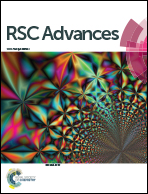Identification of preferentially exposed crystal facets by X-ray diffraction†
Abstract
Crystals with exposed facets are popular materials in many catalytic applications due to their high reactivity. Facet identification is often conducted by transmission electron microscopy (TEM). In this work, we analyze the effects of doping, vacancy creation, anisotropic broadening, and preferred orientation on the intensity of X-ray diffraction (XRD) peaks by using tetragonal bismuth oxyhalides (BiOX, X = Cl, Br, and I) as examples. The differences in these effects were successfully used to identify the preferentially exposed (001) facets of BiOX nanoplates synthesized by a polymer-assisted precipitation method. In comparison to TEM, the XRD analysis is not only cheaper and easier to perform, but also it gives results representative for the sample. This work aims to provide further justification for the use of XRD as a powerful and handy characterization technique in the field of crystal facet engineering.



 Please wait while we load your content...
Please wait while we load your content...